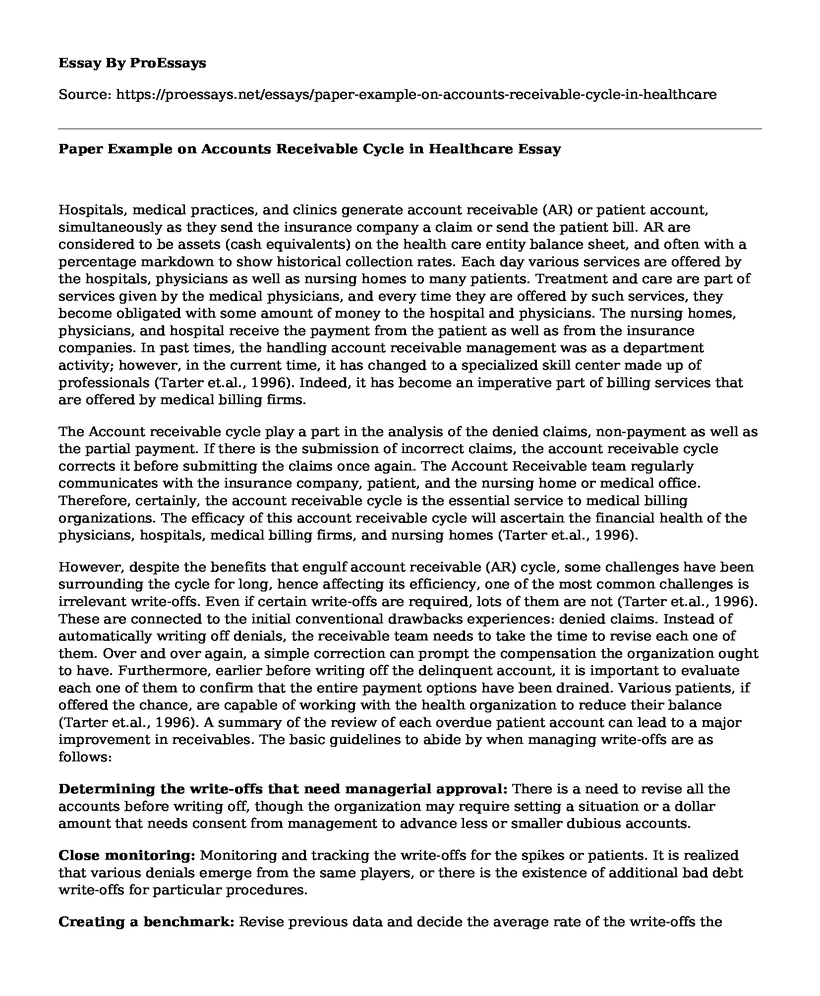Hospitals, medical practices, and clinics generate account receivable (AR) or patient account, simultaneously as they send the insurance company a claim or send the patient bill. AR are considered to be assets (cash equivalents) on the health care entity balance sheet, and often with a percentage markdown to show historical collection rates. Each day various services are offered by the hospitals, physicians as well as nursing homes to many patients. Treatment and care are part of services given by the medical physicians, and every time they are offered by such services, they become obligated with some amount of money to the hospital and physicians. The nursing homes, physicians, and hospital receive the payment from the patient as well as from the insurance companies. In past times, the handling account receivable management was as a department activity; however, in the current time, it has changed to a specialized skill center made up of professionals (Tarter et.al., 1996). Indeed, it has become an imperative part of billing services that are offered by medical billing firms.
The Account receivable cycle play a part in the analysis of the denied claims, non-payment as well as the partial payment. If there is the submission of incorrect claims, the account receivable cycle corrects it before submitting the claims once again. The Account Receivable team regularly communicates with the insurance company, patient, and the nursing home or medical office. Therefore, certainly, the account receivable cycle is the essential service to medical billing organizations. The efficacy of this account receivable cycle will ascertain the financial health of the physicians, hospitals, medical billing firms, and nursing homes (Tarter et.al., 1996).
However, despite the benefits that engulf account receivable (AR) cycle, some challenges have been surrounding the cycle for long, hence affecting its efficiency, one of the most common challenges is irrelevant write-offs. Even if certain write-offs are required, lots of them are not (Tarter et.al., 1996). These are connected to the initial conventional drawbacks experiences: denied claims. Instead of automatically writing off denials, the receivable team needs to take the time to revise each one of them. Over and over again, a simple correction can prompt the compensation the organization ought to have. Furthermore, earlier before writing off the delinquent account, it is important to evaluate each one of them to confirm that the entire payment options have been drained. Various patients, if offered the chance, are capable of working with the health organization to reduce their balance (Tarter et.al., 1996). A summary of the review of each overdue patient account can lead to a major improvement in receivables. The basic guidelines to abide by when managing write-offs are as follows:
Determining the write-offs that need managerial approval: There is a need to revise all the accounts before writing off, though the organization may require setting a situation or a dollar amount that needs consent from management to advance less or smaller dubious accounts.
Close monitoring: Monitoring and tracking the write-offs for the spikes or patients. It is realized that various denials emerge from the same players, or there is the existence of additional bad debt write-offs for particular procedures.
Creating a benchmark: Revise previous data and decide the average rate of the write-offs the health organizations experience. The importance of monitoring the trend is that one can distinguish and develop the strategy to mitigate the write-offs that were not controlled; this will be followed by the establishment of a limit or baseline for annual write-offs that can be controlled.
Conclusion
Conclusively, that account receivable cycle is imperative to the health sector and insurance companies since they lessen the patients access to the medical services. Although, the account receivable cycle can mess up the health organization and drown it to bankruptcy if not well managed. Irrelevant write-offs emerge to be the common problem facing the account receivable cycle in the health care system, and if the health organization respects the stated measure, then they should not worry about experiencing any loss.
References
Tarter, F. B., Greene, J. M., De Fazio, T. J., Peck, J., Wylie, L. S., Magnotte, M. M., ... & Tarter, S. A. (1996). U.S. Patent No. 5,550,734. Washington, DC: U.S. Patent and Trademark Office.
Cite this page
Paper Example on Accounts Receivable Cycle in Healthcare. (2021, Apr 20). Retrieved from https://proessays.net/essays/paper-example-on-accounts-receivable-cycle-in-healthcare
If you are the original author of this essay and no longer wish to have it published on the ProEssays website, please click below to request its removal:
- Essay on Plasmapheresis and Autoimmune Infection
- Health Disparities in Mississippi Essay
- Research Paper on Obesity as a Current Health Issue
- Adults: Vaccines Essential for Improved Health & Disease Prevention - Essay Sample
- Essay Sample on Nursing Researchers: Uncovering Validity and Relevancy in Studies Using PICOT
- Essay Example on Genetically Modified Foods: Benefits for Global Food Security
- Hand, foot & mouth disease in Vietnam: (HC)







